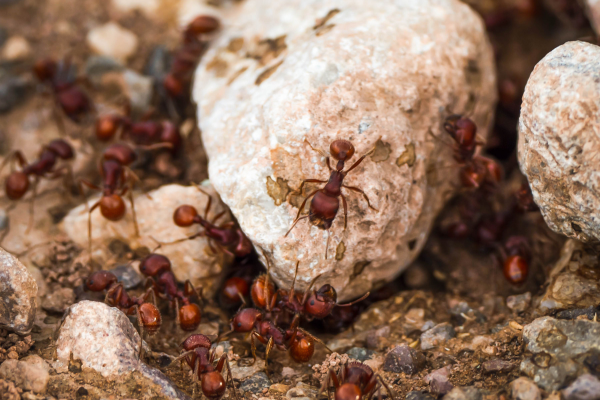Your cart is currently empty!

03 Jul The Basics of Fire Ants: A Quick Introduction
Fire ants, with their painful bites and aggressive behaviour, have become notorious creatures that pose risks to both ecosystems and human health. In this article, we will explore the fundamental aspects of fire ants, including their behaviour, characteristics, and environmental impact.
1. Identification And Habitat:
Fire ants belong to the Solenopsis genus and are known scientifically as Solenopsis invicta. Originally native to South America, they have now spread to various parts of the world, including the southern United States, Australia, and China. Fire ants are small, ranging from 1/8 to 1/4 of an inch in length, and can be identified by their reddish-brown colouration.
2. Social Structure And Behaviour:
Fire ants are highly social insects that live in large colonies consisting of a queen, male drones, and female worker ants. The queen is responsible for reproduction, while the worker ants perform various tasks such as foraging, building nests, and defending the colony. Fire ants are known for their aggressive behaviour and can attack in large numbers when their nest is disturbed.
3. Nest Construction:
Fire ants construct intricate nests consisting of underground tunnels and chambers. These mounds can be quite large, reaching heights of several feet. The tunnels provide protection from predators, regulate temperature and humidity, and serve as a central hub for the colony’s activities. The mounds also have a characteristic dome-shaped appearance, which helps to distinguish fire ant nests from other ant species.
4. Feeding Habits:
Fire ants are omnivorous, meaning they consume both plant and animal matter. They are opportunistic foragers and will scavenge for food, feeding on dead insects, seeds, fruits, and even small vertebrates. Fire ants also have a remarkable ability to adapt to different food sources, allowing them to thrive in a variety of environments.
5. Sting And Defensive Mechanisms:
One of the defining features of fire ants is their painful sting. When threatened or disturbed, fire ants will aggressively defend their colony by stinging their target repeatedly. The sting of a fire ant injects a venom that causes a burning sensation, leading to the name “fire ant.” Some individuals may experience allergic reactions to fire ant stings, which can range from mild itching and swelling to severe anaphylaxis.
6. Ecological Impact:
The presence of fire ants can have significant ecological consequences. Their aggressive behaviour and ability to outcompete native ant species can disrupt ecosystems. Fire ants also prey on other insects, including pollinators, which can have far-reaching effects on the balance of ecosystems. Additionally, their mounds can damage crops, and electrical equipment, and disrupt soil stability.
7. Management And Control:
Due to the negative impact of fire ants on both human health and the environment, various methods have been developed to manage and control their populations. These include the use of chemical insecticides, biological control agents, and integrated pest management techniques. Efforts are also being made to develop fire ant-resistant crops and educate the public about prevention and control measures.
To address the challenges posed by fire ants, it is essential to support and utilize effective management and control methods. One such solution is NemaKnights Ant Attack, an environmentally friendly product designed to combat fire ant infestations. NemaKnights Ant Attack targets and reduces fire ant populations without harming other beneficial insects or the environment.
By choosing NemaKnights Ant Attack, we can actively contribute to protecting our ecosystems and promoting the well-being of both humans and nature. Together, we can tackle the challenges presented by fire ants and foster a healthier, more balanced ecosystem for future generations. For more information about fire ants, check out our website here.


